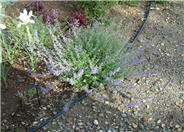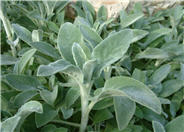
Common name:Catmint
Botanical name:Nepeta X faassenii
Nepeta faassenii makes soft, grey-green, undulating mounds to 1' tall in bloom, spreading 3'-4' wide. The small leaves are attractive to cats. This perennial has lavender blue flowers in summer. Catmint can be planted in sun or shade and needs medium amount of water. Prune spent flowers to encourage more blooms.

Common name:California Sycamore
Botanical name:Platanus racemosa
The California Sycamore is a fast growing, deciduous tree that reaches up to 40'-50' high. It tolerates heat, smog, and moist conditions; it is native to riparian areas. It has an interesting mottled bark when the tree is bare in winter. It needs a moderate amount of watering unless the water table is high. Leaves turn yellow in fall before dropping. Hummingbirds and butterflies love the Sycamore.

Common name:Chocolate Ruffles Coral Bells
Botanical name:Heuchera 'Chocolate Ruffles'
The evergreen ruffled-edged, chocolate colored foliage grows to less than 1' tall. Small white flowers bloom in spring and summer, making the overall height of this plant 2' tall. It prefers part or full shade and medium amount of watering with well draining soil.

Common name:Lamb's Ear
Botanical name:Stachys byzantina
This tiny shrub will grow less than 1' tall and has medium-size, greyish-green leaves with blue and lavender flowers that bloom in the spring. This shrub is grown more for its velvety leaves than the flowers. It is drought tolerant once it's established. Be careful not to overwater.

Common name:Waxleaf Privet
Botanical name:Ligustrum japonicum 'Texanum'
This dense, evergreen shrub reaches 6'-8' tall and 4'-6' wide. Waxleaf Privet has dark green, leathery, evergreen leaves that make a great privacy hedge. White fragrant flowers bloom in spring and summer. Bees love these flowers! Blue black berries follow bloom season. Part of this shrub may be poisonous if ingested. It prefers full sun to light shade with a medium amount of watering, more in hot summer months.

Common name:Orange or Brown Sedge
Botanical name:Carex testacea
The testacea variety is an evergreen perennial that reaches 2' tall bearing very narrow, coppery brown leaves splitting to hair-like threads at their tips, and continuing to grow to 4-8' in length. This plant should be grown in sun with little or no summer watering. During winter, foliage turns orange. If this grass is planted in shade, foliage stays green. Flowers are insignificant. Orange Sedge looks great in containers or spilling over near walkways or into water features.

Common name:Bearded Iris
Botanical name:Iris Bearded Hybrids
This perennial will grow 1'-3' tall and has medium sized, blue green leaves with flowers of different colors that bloom in spring. It needs well draining soil and full sun. Many are fragrant and rebloom in the fall. Plant rhizomes in Sept or Oct. They need water once a week during the hot spells. Top dress with compost and gypsum in January and August.

Common name:Rose selected cultivars
Botanical name:Rosa species
These shrubs and vines are the most-loved in the West and are very resilient. They come in a wide variety of sizes and colors and are easy to maintain with proper care. Roses can be espaliered or used on a trellis or as shrubs along walkways. Some are fragrant; most have thorns.
| Designer: Amy Bartell | Islands of Perennials |
Photographer: GardenSoft |
Soils and Compost:
Incorporate compost 6" into your soil to retain water, reduce compaction, feed earthworms, and provide valuable nutrients to your plants.
Water Saving Tip:
Fix leaking sprinklers, valves, and pipes.
One broken spray sprinkler can waste 10 gallons per minute - or 100 gallons in a typical 10 minute watering cycle.
Integrated Pest Management:
Drip and other smart irrigation delivers water directly to roots, allowing no excess water for weeds.
